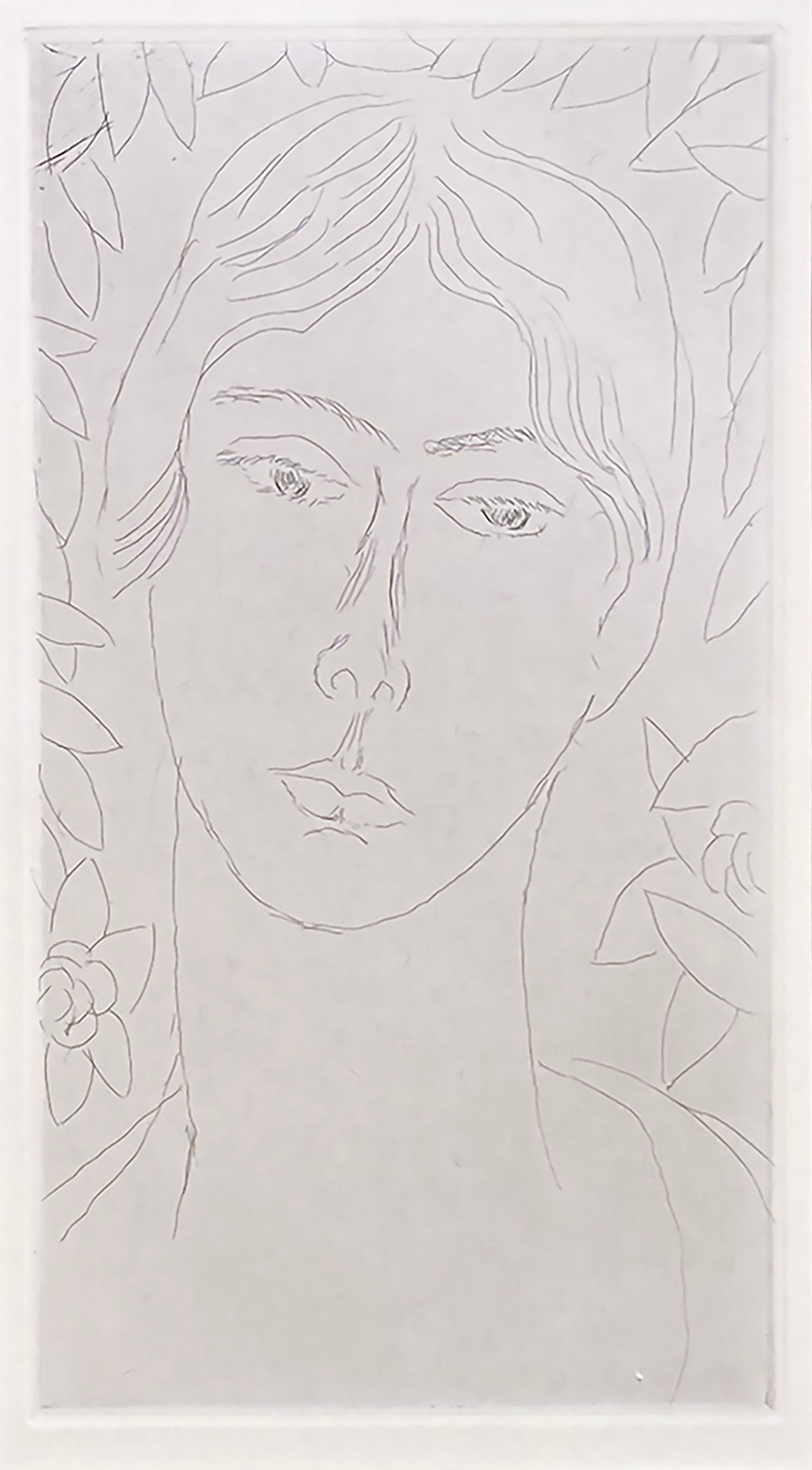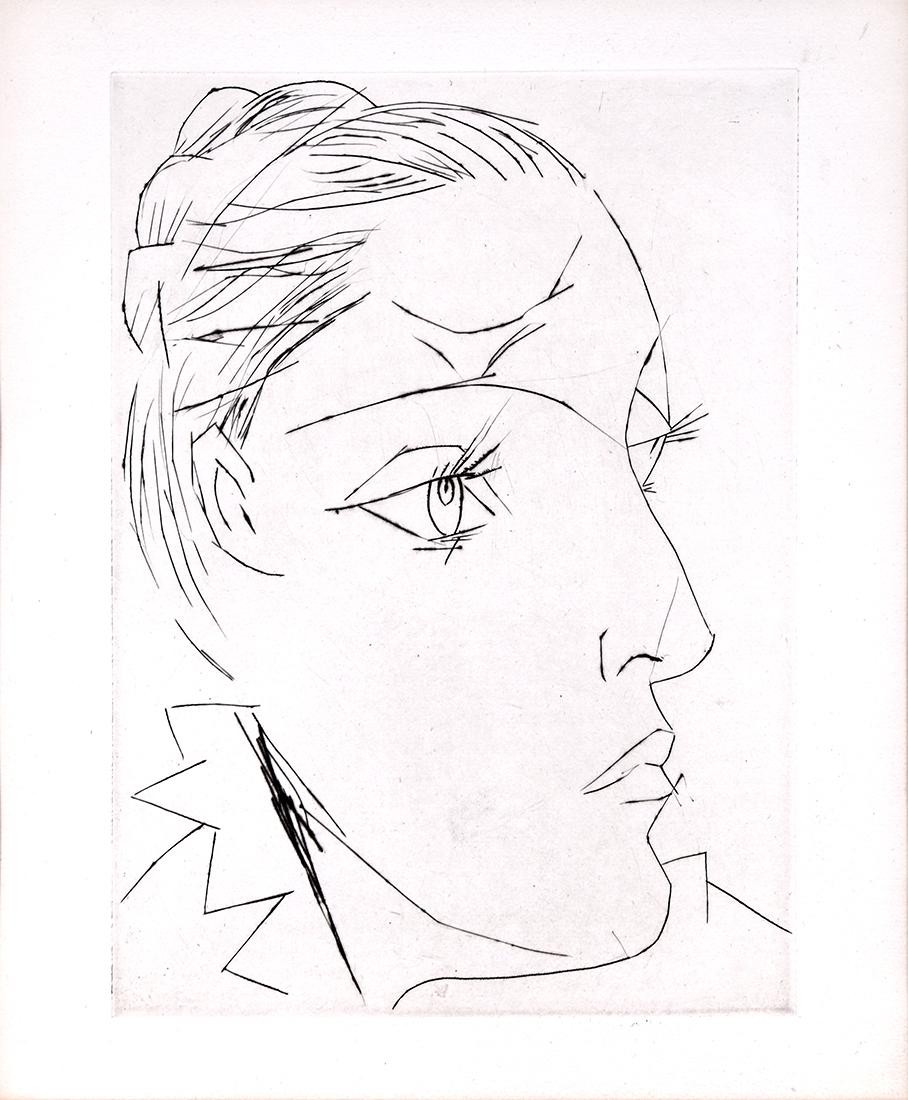Items Similar to The Princess of Ilmenau - Original Etching and Drypoint by E. Munch - 1905/6
Want more images or videos?
Request additional images or videos from the seller
1 of 4
Edvard Munch The Princess of Ilmenau - Original Etching and Drypoint by E. Munch - 1905/6 1905-1906
1905-1906
About the Item
Drypoint on copperplate.
Printed by Felsing in brown ink.
First Impression with the hand-signed inscription lower right: E M// Die Prinzessin von Ilmenau/ ister Druck/ herzlichst von E Munch
Ref.: G.Woll, Edvard Munch. The Complete Graphic Works, Philip Wilson Publishers, London 2001, p. 217, n. 264, repr.
Image dimensions: 14x9,5 cm
Includes passepartout: 49x34 cm
Very good conditions.
This artwork is shipped from Italy. Under existing legislation, any artwork in Italy created over 70 years ago by an artist who has died requires a licence for export regardless of the work’s market price. The shipping may require additional handling days to require the licence according to the final destination of the artwork.
- Creator:Edvard Munch (1863 - 1944, Norwegian)
- Creation Year:1905-1906
- Dimensions:Height: 9.45 in (24 cm)Width: 6.5 in (16.5 cm)Depth: 0.04 in (1 mm)
- Medium:
- Movement & Style:
- Period:
- Condition:Insurance may be requested by customers as additional service, contact us for more information.
- Gallery Location:Roma, IT
- Reference Number:
About the Seller
4.9
Platinum Seller
These expertly vetted sellers are 1stDibs' most experienced sellers and are rated highest by our customers.
1stDibs seller since 2017
Typical response time: 2 hours
- ShippingRetrieving quote...Ships From: Rome, Italy
- Return PolicyA return for this item may be initiated within 14 days of delivery.
More From This SellerView All
- The Old Teacher of Philosophy - Original Drypoint by Jeanne Bardey - 1913By Jeanne BardeyLocated in Roma, ITThe Old Teacher of Philosophy is an original artwork realized by French Artist Jeanne Bardey (1872 - 1954) Drypoint print. Hand-signed on the lower right in pencil, on up dated 191...Category
1910s Modern Figurative Prints
MaterialsDrypoint
- Trajan - Drypoint Etching attr. to Salvador Dalì - 1973By Salvador DalíLocated in Roma, ITTrajan is an original contemporary artwork realized in 1973. Black and white drypoin etching. Hand signed on the lower margin. Numbered on the lower left. Edition of 216/261. Ref...Category
1970s Surrealist Figurative Prints
MaterialsDrypoint, Etching
- Self Portrait - Drypoint after Giuseppe Viviani - 1983By Giuseppe VivianiLocated in Roma, ITSelf Portrait is a drypoint realized after Giuseppe Viviani in 1983. Hand signed and numbered. 1983 edition of 100 prints. Signed by the Artist widow "Eralda Benso Viviani". Refe...Category
1980s Modern Figurative Prints
MaterialsDrypoint
- Madame M. - Original Etching and Drypoint by C.A. Waltner - 1894By Charles Albert WaltnerLocated in Roma, ITMadame M. is a black an white etching and drypoint realized by a French artist active at the end of XIX century, Maurice Deville in 1894. This original print, representing a superb...Category
1890s Modern Figurative Prints
MaterialsEtching, Drypoint
- Promenade dans la Neige - Etching by J. Tissot - 1880By James TissotLocated in Roma, ITBeautiful print on verge crème, 2° state on 3, with letters printed in red. Stamp “Lugt 1545”. Little crack and fold on lower left margin of the sheet. Some small traces of oxidati...Category
1880s Post-Impressionist Portrait Prints
MaterialsDrypoint, Etching
- Portrait of Adolph Menzel - Etching by Giovanni Boldini - 1897By Giovanni BoldiniLocated in Roma, ITPortrait of Adolph Menzel is a magnificent drypoint realized by Giovanni Boldini in 1897. Reference: Buzzoni / M. Toffanello, Museo Giovanni Boldini, G...Category
1890s Modern Portrait Prints
MaterialsEtching, Drypoint
You May Also Like
- "La Promanade" Black and White Print of a Women in a Carriage EditionBy Edgar ChahineLocated in Houston, TXBlack and white print of an upper class women in a carriage. There are other figures in the back riding in a carriage as well. Edition 17 of 58. Painting is signed by the artist and ...Category
Early 1900s Expressionist Figurative Prints
MaterialsEngraving
- Olliver St. John GogartyBy Gerald Leslie BrockhurstLocated in Storrs, CTOliver St. John Gogarty. 1935. Etching. Fletcher 78. 6 7/8 x 5 1/2 (sheet 11 1/4 x 8 3/8). Edition 100. 75 intended for the Cuala Press, Dublin. A rich impression, printed on cream-...Category
Mid-20th Century Modern Portrait Prints
MaterialsDrypoint, Etching
- My DaughterLocated in Middletown, NYDrypoint etching on buff wove paper, 9 3/4 x 12 3/4 inches (250 x 322 mm), full margins. Signed in pencil, lower right margin. Some general age tone, and minor mat tone around the pe...Category
Early 20th Century Modern Portrait Prints
MaterialsEtching, Drypoint
- Bibi ValentinBy James Abbott McNeill WhistlerLocated in Storrs, CTBibi Valentin. 1859. Etching and drypoint. Kennedy catalog 50 state ii; Glasgow catalog 34 state ii. 6 x 8 7/8 (sheet 8 11/16 x 10 11/16). Glasgow records 44 known impressions. A rich impression with burr, printed on watermarked laid paper with full margins. Signed and dated in the plate. Housed in a 20 x 16-inch archival mat A young girl, sits facing the viewer, leaning on her left elbow, legs extended to left. She wears a high-necked smock and buttoned boots...Category
19th Century American Modern Portrait Prints
MaterialsEtching, Drypoint
- "Mlle Landsberg" (grade planche, pl. 16)By Henri MatisseLocated in Missouri, MO"Mlle Landsberg" (grade planche, pl. 16), 1914 Henri Matisse (French, 1869-1954) Signed and Numbered Lower Right Edition 12/15 Image size: 7 7/8 x 4 5/16 inches Sheet size: 17 11/16 x 12 1/2 inches With frame: 19 1/2 x 14 1/2 inches Henri Matisse came from a family who were of Flemish origin and lived near the Belgian border. At eight o'clock on the evening of December 31, 1869, he was born in his grandparents' home in the town of Le Cateau in the cheerless far north of France. His father was a self-made seed merchant who was a mixture of determination and tightly coiled tension. Henri had no clear idea of what he wanted to do with his life. He was a twenty-year-old law clerk convalescing from appendicitis when he first began to paint, using a box of colors given to him by his mother. Little more than a year later, in 1890, he had abandoned law and was studying art in Paris. The classes consisted of drawing from plaster casts and nude models and of copying paintings in the Louvre. He soon rebelled against the school's conservative atmosphere; he replaced the dark tones of his earliest works with brighter colors that reflected his awareness of Impressionism. Matisse was also a violinist; he took an odd pride in the notion that if his painting eye failed, he could support his family by fiddling on the streets of Paris. Henri found a girlfriend while studying art, and he fathered a daughter, Marguerite, by her in 1894. In 1898 he married another woman, Amelie Parayre. She adopted the beloved Marguerite; they eventually had two sons, Jean, a sculptor and Pierre who became an eminent art dealer. Relations between Matisse and his wife were often strained. He often dallied with other women, and they finally separated in 1939 over a model who had been hired as a companion for Mme. Matisse. She was Madame Lydia, and after Mme. Matisse left, she remained with Matisse until he died. Matisse spent the summer of 1905 working with Andre Derain in the small Mediterranean seaport of Collioure. They began using bright and dissonant colors. When they and their colleagues exhibited together, they caused a sensation. The critics and the public considered their paintings to be so crude and so roughly crafted that the group became known as Les Fauves (the wild beasts). By 1907, Matisse moved on from the concerns of Fauvism and turned his attention to studies of the human figure. He had begun to sculpt a few years earlier. In 1910, when he saw an exhibition of Islamic art, he was fascinated with the multiple patterned areas and adapted the decorative universe of the miniatures to his interiors. As a continuation of his interest in the "exotic", Matisse made extended trips to Morocco in 1912 and 1913. At the end of 1917, Matisse moved to Nice; he would spend part of each year there for the remainder of his life. A meticulous dandy, he wore a light tweed jacket amd a tie when he painted. He never used a palette, but instead squeezed his colors on to plain white kitchen dishes...Category
1910s Fauvist Figurative Prints
MaterialsEtching, Drypoint
- Portrait De Dora Maar Au Chignon.IIBy (after) Pablo PicassoLocated in Palo Alto, CACreated in 1936, this drypoint on laid paper is stamped by the Picasso Estate Collection via Marina Picasso on verso. This work is a rare proof, aside from the numbered and signed ed...Category
1930s Modern Portrait Prints
MaterialsDrypoint



